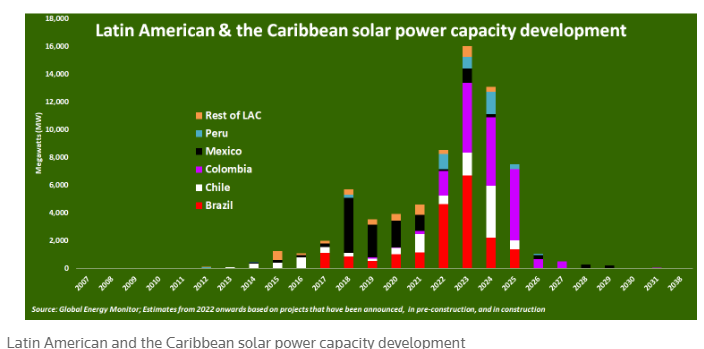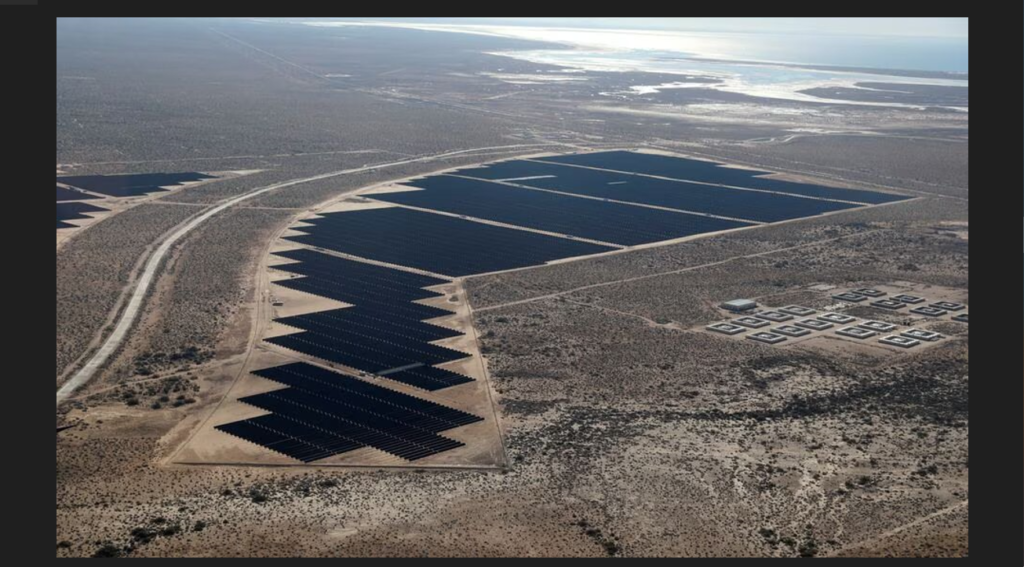LITTLETON, Colorado (Reuters) — Countries in the Caribbean and Latin America have the largest solar power development pipeline outside Eastern Asia and North America, making the bloc a key renewable hot spot to track over the coming decade.
The region is constructing over four times the amount of solar capacity being built across Europe, and nearly seven times more than in India, the world’s third largest solar producer, data as of January 2023 from Global Energy Monitor (GEM) shows.

Solar power currently generates only 3%-4% of the electricity produced across Latin America and the Caribbean (LAC), according to data from think tank Ember.
But with nearly 250 projects constructing 19,429 megawatts (MW) of solar power capacity, the region’s solar power supply potential is primed to jump by at least 70% from current levels once projects are completed, GEM data shows.
An additional 97,119 MW of capacity has been announced or in pre-construction phase, which is more than slated in the same categories in North America, according to GEM.
Alongside planned expansions in wind energy capacity that are also underway, the collective increase in solar output looks set to sharply boost clean energy supply across LAC, and may help slow the escalation of power sector emissions that have already climbed by more than 25% since 2010.
POWER PUSHERS
The main drivers behind the solar push are the region’s largest economic and industrial heavyweights: Brazil, Mexico, Colombia, Chile and Peru.
Collectively, those five countries account for over 88% of current installed solar capacity and about 97% of planned capacity additions that are already in construction.

Those same countries also account for roughly 65% of the area’s power sector emissions of carbon dioxide (CO2), according to Ember, and have expanded pollution totals by nearly 36% since 2010, compared to the 25% rise in collective discharge by the LAC group as a whole.
That means that any boost to clean energy supplies in the five largest LAC economies may help clip the collective pollution stemming from the entire region, and contribute towards global efforts to cap global CO2 discharge before 2050.
ELECTRIC AVENUE
Major regional economies such as Brazil and Mexico have trend-setting clout among neighbouring nations, meaning that any success stories in terms of clean energy policy shifts will likely trigger copycat behaviour within their spheres of influence.
Brazil recently held talks with Mexico, Colombia and Chile to set up a framework for sustainability-linked bonds, and Brazil’s new president Luiz Inacio Lula da Silva campaigned last year on pledges to steer Brazil onto a lower emitting trajectory.
Mexico announced last year that it would double renewable energy capacity by 2030 and cut greenhouse gas emissions by 30% below business-as-usual levels by 2030.
That suggests both countries will look to take leadership positions among their peers in terms of clean energy endeavours, and follow through on renewable power initiatives.
Mexico, a major car manufacturing hub, is also targeting that 50% of its car sales will be non-emitting by 2030.
In combination, those goals spell greater demand for clean power, and support the fast-tracking of greater solar generation even beyond the current slate of announced projects.
HIGH POTENTIAL
Several countries across Latin America and the Caribbean rank highly in terms of solar photovoltaic economic potential, or the expected cost of utility-scale solar farms, according to a study by Solargis funded by the World Bank.
The study ranks countries by their levelised cost of electricity – the lifetime costs of constructing and operating a solar plant, divided by the amount of electricity produced in its lifetime.
Measured in U.S. dollars per kilowatt hour (USD/kWh), Brazil, Latin America’s top solar player in terms of installed capacity, has an average economic potential of $0.12/kWh, while Chile’s is $0.07/kWH.
That compares to $0.07/kWh for China, $0.10/kWh for the United States, and $0.07/kWH for India, the top three global solar producers.
Mexico, Peru and Colombia have similar average economic potential scores, and score even better than China and the United States in terms of theoretical solar potential, which measures the amount of solar irradiance available in each country.
That suggests that much of Latin America and the Caribbean have both attractive amounts of sunshine and competitive payback periods for large solar projects, and means the region should continue to grow as a significant global solar stomping ground.
Reporting By Gavin Maguire.
Our Standards: The Thomson Reuters Trust Principles.




Pingback: Expert Column From Reuters – Virgin Islands Free Press - CaribbeanNewsRoundup.com